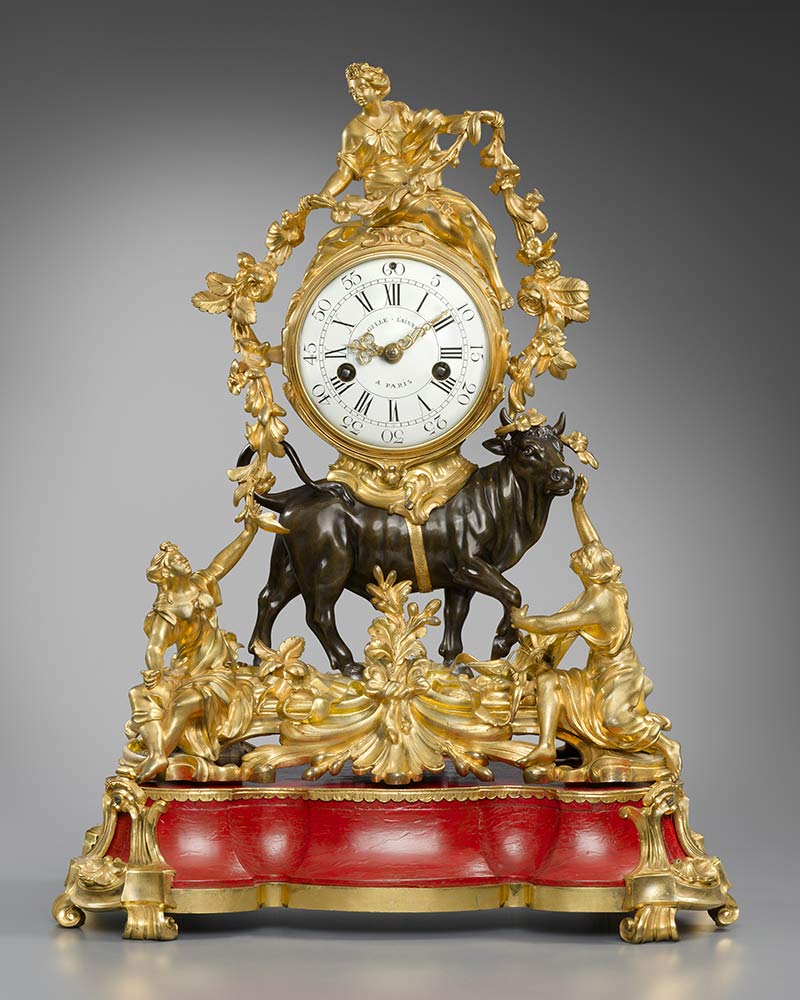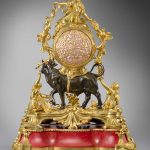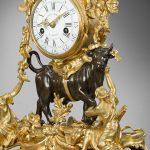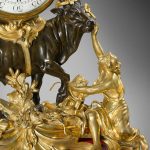A Rape of Europa clock by Osmond

Pendule ancienne
A Louis XV gilt and patinated bronze mantle clock
representing the Rape of Europa,
the dial signed Gille l’Aîné à Paris, the case signed Osmond – circa 1755-1760
Resting on an associated Louis XV gilt bronze-mounted vermillion lacquer base stamped Saint-Germain
Pierre I François Gilles l’Aîné (1690-1765), maître on 4 January 1746
Pierre II Gilles l’Aîné fils and later l’Aîné (1723-1784), maître on 18 November 1746
Robert Osmond (1711-1789), maître in 1746
Jean-Joseph de Saint-Germain (1719-1791), maître fondeur on 15 July 1748
“by order of the King’s Council of State”
Height (with base): 55.5 cm. (21 ¾ in.) Width: 44.5 cm. (17 ½ in.)
Depth: 31 cm. (12 ¼ in.)
Height (clock): 46 cm. (18 in.) Width: 36 cm. (14 ¼ in.)
Depth: 21.5 cm. (8 ½ in.)
The enamel dial bearing the signature, with Roman numerals indicating the hours and Arabic numerals for the minutes with pierced and engraved gilt brass hands. The circular movement has a recoil lever escapement and silk-thread suspension and strikes the hours and half-hours by means of a count wheel mounted on the back-plate.
Literature
G and A. Wannenes, Les plus belles pendules françaises: de Louis XIV à l’Empire, Florence, 2013, p. 89 (ill.)
Comparative Literature
Two identical clocks by Osmond are known:
One with a replacement English movement signed Vulliamy London, the case signed Osmond, on a pierced and scrolled base containing a chime in the British Royal Collection (RCIN 30424), illustrated in C. Jagger, Royal Clocks: The British Monarchy & its Timekeepers 1300-1900, London, 1983, pp. 140-141.
One with the dial signed Frédéric Duval à Paris, the case signed Osmond, illustrated in P. Kjellberg, L’Encyclopédie de la Pendule Française, Paris, 1997, pp. 132-133.
Similar clocks include:
One with the dial signed Etienne Le Noir à Paris, attributed to Osmond in the Getty Museum (73.DB.85), illustrated in G. Wilson et al., European Clocks in the J. Paul Getty Museum, Los Angeles, 1996, pp. 102-107, no. 14.
One with the dial signed Henry Blondel à Paris, sold from the collection of Madame de Polès, Galerie Georges Petit, Paris, 22-24 June 1927, lot 192.
Pierre I François Gille l’Aîné (1690-1765)
He produced a large number of clocks housed in cases with figures and porcelain flowers. He worked notably for the service of Augustus II the Strong of Saxony, as well as for Count von Brühl and the Prince de Condé.
Pierre II Gille l’Aîné fils (1723-1784)
Son of Pierre I, he worked with his father, then ran an independent workshop under the name Gille l’Aîné fils. On the death of his father, he took over the signature Gille l’Aîné.





